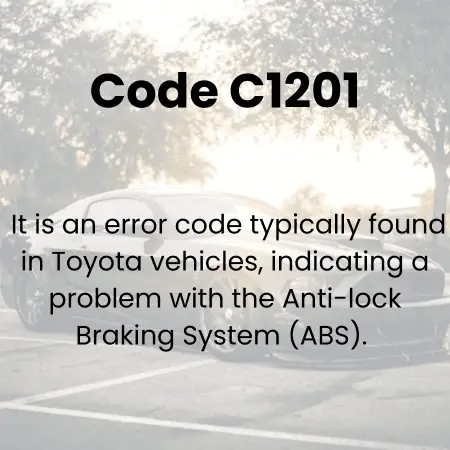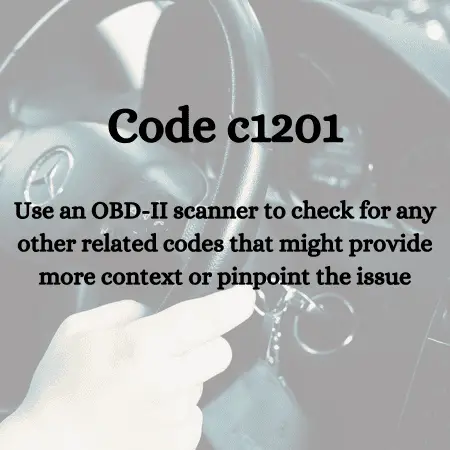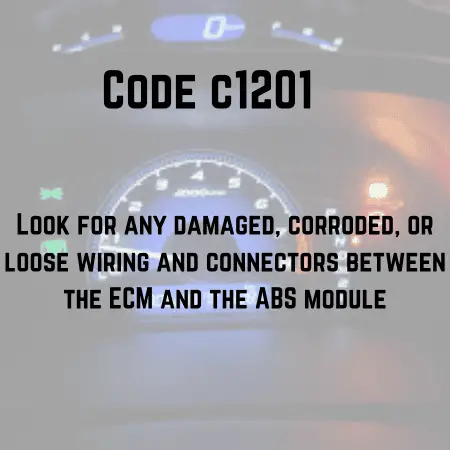Encountering a trouble code like C1201 can be frustrating, especially if you’re not familiar with automotive diagnostics. This code relates to the Anti-lock Braking System (ABS) in your vehicle and can impact its performance and safety. Understanding what code C1201 means and knowing how to fix it is crucial for maintaining your vehicle in top condition.
What is Code C1201?
Code C1201 is an error code that appears in certain vehicles. It usually means there is a problem with the Anti-lock Braking System (ABS). This system helps the car stop safely by preventing the wheels from locking up during hard braking. When the car’s computer detects an issue with the ABS, it triggers the C1201 code.

Symptoms of Code C1201
Warning Lights
The most obvious symptom of code C1201 is the illumination of the ABS warning light on your dashboard. This light signals that there is a problem within the ABS system that needs attention.
Performance Issues
In addition to warning lights, you might experience reduced braking performance. The ABS may not function correctly, which can affect your vehicle’s stopping power and control, particularly in slippery conditions.
Must Read: Is It Safe To Drive With ABS Light On? ( Detailed Answer )

Common Causes of Code C1201
Faulty ABS Sensors: The sensors, which monitor wheel speed, can malfunction if they are dirty, damaged, or worn out. This prevents accurate readings from reaching the ABS system.
Wiring Problems: Damaged, corroded, or loose wires and connectors can disrupt the communication between the ABS sensors and the car’s computer. This can trigger the error code.
Defective ABS Module: The ABS module, which processes signals from the sensors and controls the ABS system, can fail due to electrical issues or internal faults.
Low Brake Fluid: Insufficient brake fluid can affect the ABS’s performance and trigger error codes, including C1201. The brake fluid level should be checked regularly.
Faulty Wheel Bearings: Worn or damaged wheel bearings can affect the wheel speed sensors’ readings, leading to the ABS malfunctioning and generating error codes.
Issues with the Engine Control Module (ECM): Sometimes, the problem might not be with the ABS itself but with the car’s main computer (ECM). If the ECM has issues, it can mistakenly report ABS problems.
Hydraulic Problems: Issues within the hydraulic control unit of the ABS, such as leaks or blockages, can also cause the C1201 code to appear.
Addressing these common causes typically involves a thorough inspection by a mechanic to pinpoint the exact issue and perform the necessary repairs or replacements.

You May Find Helpful
- What Causes a P0087 Code & How To Fix This Issue
- Airbag Light Comes On And Off While Driving – Solutions
Step-by-Step Guide to Fix Code C1201
Certainly! Here’s a more detailed step-by-step guide to fixing Code C1201:
1- Check ABS Sensors:
Start by visually inspecting each ABS sensor located near the wheels. Ensure they are free from dirt, debris, or any obstructions that may affect their performance.
If any sensor appears dirty, gently clean it with a soft cloth and mild detergent to remove any buildup.
Next, inspect the sensor’s mounting and connection points. Ensure they are securely attached to the wheel hub and free from any damage or corrosion.
If any sensor is damaged, worn out, or shows signs of malfunction, it will need to be replaced with a new one compatible with your vehicle’s make and model.
2- Inspect Wiring and Connections:
Carefully examine the wiring harnesses and connectors that link the ABS sensors to the car’s main computer (ECU).
Look for any signs of damage, such as frayed wires, corrosion, or loose connections.
Repair or replace any damaged wires or connectors to ensure a secure and reliable connection between the sensors and the ECU.
Once repairs are made, securely fasten the wiring harnesses and connectors to prevent any future issues.
3- Test ABS Module:
Utilize a diagnostic scan tool compatible with your vehicle to access the ABS module’s diagnostic capabilities.
Perform a comprehensive diagnostic scan of the ABS module to check for any error codes or malfunctions.
If the scan detects any faults or issues with the ABS module, further diagnosis may be necessary to determine the exact cause of the problem.
Depending on the severity of the issue, repair or replace the ABS module as recommended by a qualified mechanic or technician.
4- Verify Brake Fluid Level:
Open the hood of your vehicle and locate the brake fluid reservoir, typically located near the firewall on the driver’s side.
Check the brake fluid level using the markings on the reservoir. Ensure it meets the manufacturer’s recommended level.
If the brake fluid level is low, carefully add the appropriate type of brake fluid until it reaches the correct level.
Avoid overfilling the reservoir, as this can lead to brake system malfunctions and safety hazards.
5- Inspect Wheel Bearings:
Lift the vehicle using a jack and secure it with jack stands to ensure stability and safety.
Rotate each wheel by hand and listen for any unusual noises, such as grinding or rumbling, which may indicate worn or damaged wheel bearings.
Additionally, check for excessive play or looseness in the wheel bearings by gently rocking the wheel from side to side.
If any wheel bearings show signs of wear, damage, or excessive play, they will need to be replaced to ensure proper functioning of the ABS system.
6- Check Engine Control Module (ECM):
Connect a diagnostic scan tool to the vehicle’s OBD-II port to access the ECM’s diagnostic capabilities.
Perform a thorough diagnostic scan of the ECM to identify any error codes or malfunctions related to the ABS system.
Address any ECM issues detected, such as software glitches or hardware failures, to ensure accurate communication and operation of the ABS system.
Follow the manufacturer’s recommendations for repairing or replacing the ECM as needed.
7- Examine Hydraulic Control Unit:
Locate the hydraulic control unit (HCU) of the ABS system, typically mounted near the brake master cylinder or ABS module.
Inspect the HCU for any signs of leaks, damage, or blockages in the hydraulic lines or valves.
If any leaks or damage are found, repair or replace the affected components to restore proper hydraulic function.
Ensure all hydraulic connections are tight and secure to prevent any potential fluid leaks or air intrusion into the ABS system.
8- Clear Error Codes:
Once all necessary repairs and replacements have been completed, use the diagnostic scan tool to clear the error codes stored in the vehicle’s memory.
Follow the prompts on the scan tool to erase the C1201 code and any other related codes associated with the ABS system.
Verify that the error codes have been successfully cleared from the system before proceeding to the next step.
9- Test Drive:
Take the vehicle for a test drive under various driving conditions to evaluate the performance of the ABS system.
Pay close attention to how the brakes respond during braking maneuvers, including hard stops and slippery road conditions.
Monitor the dashboard for any warning lights or indicators that may illuminate during the test drive, indicating potential issues with the ABS system.
If the ABS operates smoothly without any abnormal noises, vibrations, or warning lights, the repairs were successful, and the C1201 code should no longer appear.
By following these steps and performing thorough inspections and repairs, you can effectively diagnose and fix the underlying issues causing Code C1201, restoring proper functionality and safety to the ABS system in your vehicle.
Further Readings
Conclusion
Fixing code C1201 is essential for maintaining your vehicle’s safety and performance. By understanding what this code means and following the steps outlined in this guide, you can diagnose and repair the issue effectively. Regular maintenance and timely repairs are key to preventing future problems. If you encounter difficulties, don’t hesitate to seek professional help to ensure your ABS system functions correctly.
